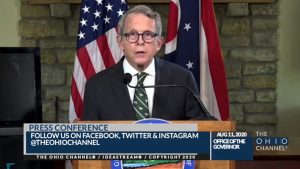News
DeWine, Ohio’s Top Pediatricians Offer Back-To-School COVID-19 Advice
By: Glenn Forbes | WCPN
Posted on:
COLUMBUS, Ohio (WCPN) — Ohio Gov. Mike DeWine and leaders from the state’s top children’s hospitals on Tuesday offered advice on how children can return to school in a safe manner and offered statistics on the impact of COVID-19 on kids.

Dr. John Barnard of Nationwide Children’s Hospital said to be clear, children get COVID-19 and can get it often, but a large percentage handle it well.
“We know that about 90 percent of them do really exceedingly well. However, a smaller fraction, 10 percent or maybe a little bit less actually get sick and need to be in the hospital,” he said.
Barnard added 17-year-olds seem to be contracting coronavirus at higher rates than their younger peers, which could be because they are more likely to socialize with more people.
When a child is sick with the coronavirus, those who were in close contact for 15 minutes or more need to isolate, according to Dr. Adam Mezoff, chief medical officer at Dayton Children’s Hospital. If others in contact with that child develop symptoms, they may need to isolate as well, he said.
Mezoff’s main message was, if you’re sick – even if it’s not COVID – stay home.
Data shows younger children are actually more likely to spread coronavirus because of the close-contact care required for infants and toddlers, said Dr. Patty Manning, chief of staff at Cincinnati Children’s Hospital.
Manning said in-person classes are preferable for older children, but must be done safely. And she would feel safe putting her kids on a bus, even though it’s a confined space.
“The good news is children are facing forward, if they’re behaving on the bus, they’re facing forward,” she said. “If they’re wearing masks, if they’re not sick, if they practice hygiene before and after being on the bus I think children can ride the bus safely.”
Manning shared four specific strategies for safe schooling, in order of importance: masking, distancing, hand hygiene and cleaning surfaces.
“We are all connected, we are all in this together. So what happens in our communities will impact our schools… if we want children to do these things, if we want children to wear masks, we have to wear masks. We have to model that behavior for them as the adults and the parents in their lives,” Manning said.
All Ohio K-12 students returning to the classroom this fall will be required to wear masks.
The health departments in Cuyahoga and Summit counties recently recommended students begin schools remotely.
DeWine said 325 Ohio school districts, approximately 38 percent of the state’s students, will start the year in the classroom. More than 25 percent of the state’s student population will be learning remotely. Another approximately 25 percent will be on a hybrid model. The governor said there are 78 districts the state does not yet have data for at this time.
“I think our schools are doing a very good job of getting ready,” he said, both for on line and in person operations.
The state’s reported coronavirus cases were generally flat with 1,095 cases reported in the last 24 hours. Deaths, considered a lagging indicator, jumped to 35 reported as of Tuesday afternoon.
DeWine also said state prison director Annette Chambers-Smith continues to recover from COVID-19 and has been cleared to return to work. She was diagnosed July 27 and according to the governor’s office, experienced only mild symptoms.
“She has now been cleared to return to work, although, frankly, I know she’s been working from home,” DeWine said. “We’re all very grateful that she’s recovered and we continue to wish her the best for a great, great recovery.”

